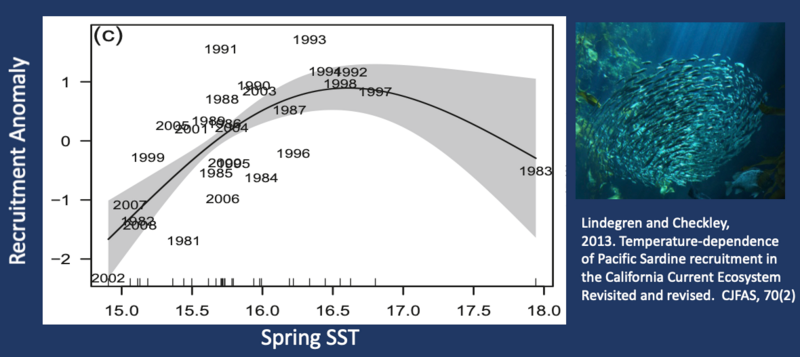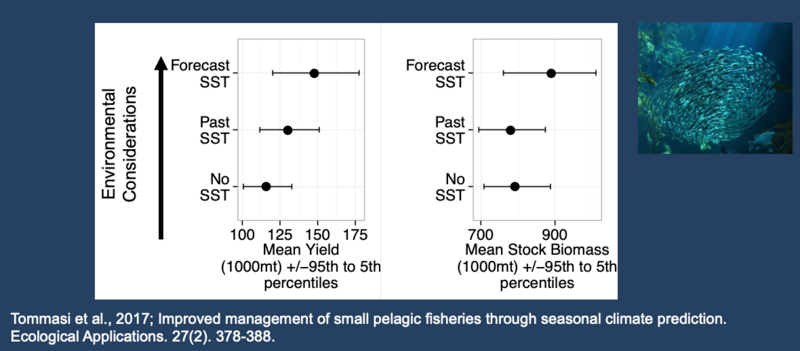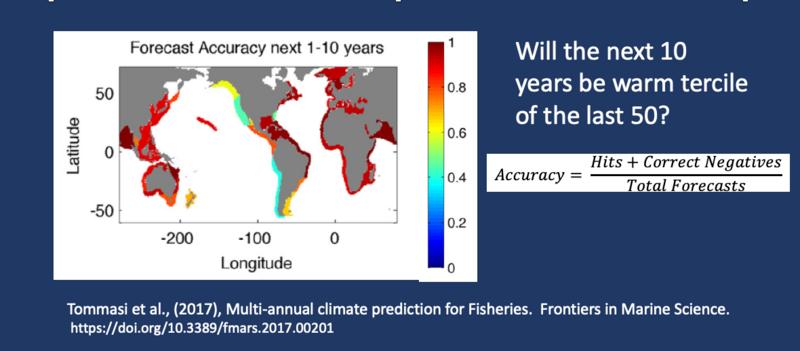Twelve Top Takeaways: from Dr. Charlie Stock’s 2021 OCB Plenary

As part of the kickoff activities for the upcoming US CLIVAR/OCB sponsored Daily to Decadal Ecological Forecasting along North American Coastlines Workshop, we will be posting a series of blogs by guest authors. The workshop aims to provide a forum for climate scientists, biogeochemists and modelers to identify sources of predictability along US coastlines, characterize observational needs, and assess gaps in understanding and model capabilities that limit ecological forecasting abilities.
The first event to kick off the Daily to Decadal Ecological Forecasting along North American Coastlines Workshop took place in June 2021, at the Ocean Carbon and Biogeochemistry summer workshop. Dr. Charlie Stock of NOAA’s Geophysical Fluid Dynamics Laboratory in Princeton, NJ, gave an introduction to the plenary session
Opportunities and challenges in ecological forecasting. If you missed it, you can watch Charlie’s talk here. In this post, I aim to condense his talk into 12 ecological forecasting takeaways.
- What is Ecological Forecasting? As defined by Clark et al. (2001), the process of predicting the state of ecosystems, ecosystem services, and natural capital with fully specified uncertainties. Charlie points out that a forecast is useful when it targets a quantity relevant to stakeholders, when the uncertainty in the forecast is clearly defined and low enough to make it useful for planning purposes, and when it is communicated accurately and clearly to managers and stakeholders.

Figure 1: Variability in Pacific Sardine recruitment is related to spring sea surface temperature in the California Current.
- Challenge 1: Is there a relationship (Figure 1) between an ecological or physical property and a relevant forecast target that may allow you to anticipate future change?
- Challenge 2: Is it possible to predict the ecological or physical property underpinning the forecast? Charlie highlights the need for re-forecast experiments, in which models are initialized and run forward for some period throughout the historical record, then analyzed for their ability to predict the observations across the relevant timescales.

Figure 2: Both fisheries yield and stock biomass can be increased with fisheries management that appropriately considers forecast variables and their uncertainty.
- Challenge 3: Does the new information available from the forecast allow managers to make decisions that improve management outcomes? For example, setting harvest control rules that increase fishery yields without compromising stock biomass (Figure 2); or enabling more targeted shellfish closures to maintain coastal economies while protecting public health.
- Tools: Short-term nearshore forecast models on timescales of days to a week are increasingly available to support ecological forecasts. These can be leveraged for Lagrangian transport of contaminants, for physical predictors that might be inputs to habitat models or linked to the target forecast, or for other purposes.

Figure 3: Useful decadal predictability can come from simple measures of a warming climate.
- Opportunity 1: Predictability for quantities like sea surface temperature occurs at a range of temporal scales around the global ocean and is underutilized. Even at decadal scales, there is predictability in coastal sea surface temperature anomalies (Figure 3 ) due to trends in human-derived climate change.
- Opportunity 2: Subsurface ocean properties are harder to observe but may be excellent predictors for longer-term forecasts. Novel observing system technologies, like profiling floats with biogeochemical sensors (BGC-Argo), may provide new data on subsurface processes to aid in extending forecasts out to the interannual and decadal range.
- Opportunity 3: The expansion of physical climate and ocean prediction systems to include ocean biogeochemistry and other earth system components revealed promising levels of predictability for ecosystem indicators and drivers, such as chlorophyll and oxygen (e.g., Park et al. 2019).
- Needs 1: Mechanistic linkages, i.e. “Science”, are still needed to understand the observed relationships between environmental predictors and ecosystems to develop robust forecast skill in a variable and changing climate.
- Needs 2: Conversations between scientists, modelers, and operational oceanographers are necessary to exchange information about possible forecasting opportunities, such as what timescales can be exploited, and what factors drive the link between forecast ecosystem, and the predictor relationships.
- Needs 3: Observations from both surface and subsurface remain essential for model development and validation.
- Resources: Charlie highlighted some great reviews of topics in ecological forecasting for further exploration, listed below:
- Tommasi et al. (2017) Managing Living Marine Resources in a dynamic environment: The role of seasonal to decadal climate forecasts. Progress in Oceanography 152, 15-59. https://doi.org/10.1016/j.pocean.2016.12011
- Payne et al. (2017) Lessons from the first generation of marine ecological forecast products. Frontiers in Marine Science. https://doi.org/10.3389/fmars.2017.00289
- Capotondi et al. (2019) Observational needs supporting marine ecosystem modeling and forecasting: From the global ocean to regional and coastal systems. Frontiers in Marine Science. https://doi.org/10.3389/fmars.2019.00623
- Jacox et al. (2020) Seasonal to interannual prediction of North American coastal marine ecosystems: Forecast methods, mechanisms of predictability, and priority developments. Progress in Oceanography. 183 https://doi.org/10.1016/j.pocean.2020.102307
- Stock et al. (2015) Seasonal sea surface temperature prediction for coastal ecosystems. Progress in Oceanography. 137,219-236.
Further reading:
- Clark et al. (2001). Ecological Forecasting: an emerging imperative. Science. Vol. 293, 657-660.
- Park et al. (2019). Seasonal to multi-annual marine ecosystem prediction with a global earth system model. 365, 284-288.

reforecast data